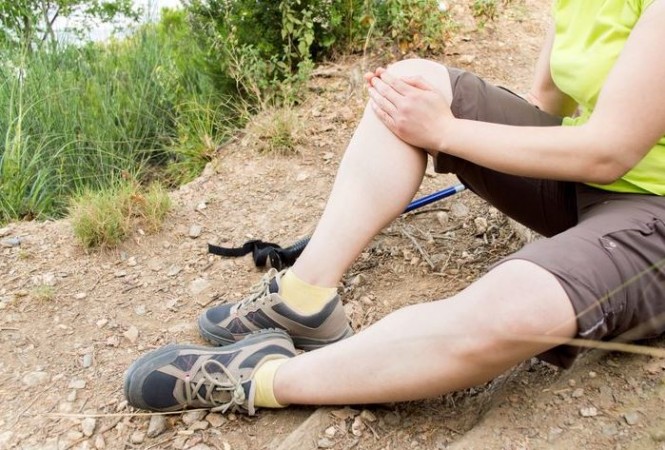
Himachal Pradesh and Uttarakhand boast numerous trekking destinations, each with its unique charm. While well-established trails exist in many places, some routes can be challenging, leading to knee pain and discomfort for trekkers. A recent incident involved a young woman who experienced knee pain weeks after a trek. Upon consulting a doctor, she learned about cartilage damage, emphasizing the importance of knee care during trekking. In this article, we will explore the common causes of knee pain during trekking and provide tips on prevention.
Causes of Knee Pain During Trekking:
Poor Trekking Practices:
Explanation: Walking on uneven surfaces, descending steep slopes, or navigating challenging terrains can subject the knees to excessive stress. The knees bear two to three times the normal pressure during such activities, contributing to pain and discomfort.
Preventive Measures: Focus on maintaining proper trekking techniques, including controlled descents and avoiding abrupt steps. Prioritize well-maintained trails and use trekking poles for added stability.
Improper Footwear:
Explanation: Inadequate footwear can significantly impact knee health during trekking. Ill-fitting shoes or those lacking proper support may contribute to misalignment and increased stress on the knees.
Preventive Measures: Invest in quality trekking shoes that provide adequate ankle and arch support. Ensure a proper fit and break in the shoes before embarking on an extended trek.
Excessive Weight:
Explanation: Carrying a heavy backpack can strain the entire lower body, including the knees. The added weight increases the load on knee joints, potentially leading to pain and discomfort.
Preventive Measures: Pack smartly, carrying only essential items. Distribute weight evenly in the backpack and use trekking poles to reduce the load on the knees.
Inadequate Knee Strengthening:
Explanation: Insufficient strength in the knee muscles can make them more susceptible to stress and injury during trekking. Weakness in the surrounding muscles can exacerbate the pressure on the knees.
Preventive Measures: Incorporate regular knee-strengthening exercises into your fitness routine. Focus on exercises targeting the quadriceps, hamstrings, and glute muscles to enhance overall knee stability.
Types of Knee Pain:
Continuous Pain Beneath the Knees:
Explanation: Persistent pain beneath the knees, especially during descents, may indicate damage to the knee cartilage. This condition can result from increased pressure on the cartilage while navigating downward slopes.
Preventive Measures: Strengthen the muscles around the knees through targeted exercises. Utilize knee braces for added support during descents.
Pain Above the Knee:
Explanation: Pain above the knee can be attributed to inflammation in the tendons, often caused by prolonged trekking. This discomfort may arise from excessive strain on the tendons, particularly during uphill climbs.
Preventive Measures: Include adequate warm-up exercises before trekking to prepare the tendons for increased activity. Stretching during breaks can help alleviate tension.
Widespread Pain Across the Entire Knee:
Explanation: Severe and widespread knee pain, possibly intensified by trekking on challenging terrain, could be linked to a prior knee injury. Trekking may exacerbate existing conditions, leading to acute discomfort.
Preventive Measures: Exercise caution on challenging terrains, and if you have a pre-existing knee condition, consult with a healthcare professional before embarking on a trek. Utilize knee braces for added support.
Preventive Measures for Knee Pain:
Exercise:
Explanation: Engaging in targeted exercises to strengthen the knee muscles is crucial for preventing pain during trekking. Wall-sit exercises and hip thrusts specifically contribute to lower body stability.
Implementation: Include these exercises in your regular workout routine, focusing on building strength in the quadriceps, hamstrings, and glute muscles. Consistency is key for long-term benefits.
Knee Braces:
Explanation: Knee braces provide external support to the knee joint, reducing the risk of injury and stabilizing the surrounding muscles. They are particularly beneficial during descents and challenging terrains.
Implementation: Wear knee braces during treks, especially if you have a history of knee issues or anticipate challenging terrain. Ensure a proper fit for optimal support.
Trekking Poles:
Explanation: Trekking poles offer additional support and stability during trekking. They reduce the impact on the knees by up to 25%, providing assistance in maintaining balance on uneven surfaces.
Implementation: Use trekking poles consistently, especially during descents and on challenging trails. Adjust the length of the poles to match the terrain and your height.
Walking Technique:
Explanation: Paying attention to your walking technique, especially during descents, can significantly impact knee health. Avoid abrupt steps and focus on a controlled motion to minimize strain on the knees.
Implementation: Practice controlled descents during training sessions. Be mindful of your steps and use trekking poles to aid in balance and stability.
Stretching:
Explanation: Warming up before trekking and incorporating stretching exercises afterward is vital for preventing muscle tension and discomfort. Stretching improves flexibility and reduces the risk of injuries.
Implementation: Prioritize dynamic warm-up exercises before the trek, including leg swings and lunges. Perform static stretches during breaks to release muscle tension.
In conclusion, knee pain during trekking can be effectively mitigated through a combination of proper preparation, preventive measures, and targeted exercises. By understanding the causes of knee pain, implementing specific strategies, and adopting a proactive approach to knee health, trekkers can enjoy their outdoor adventures without compromising their well-being. Remember, the key to a pain-free trek lies in a holistic approach that includes strengthening exercises, supportive gear, and mindful trekking practices.
Is Red Wine Good for Your Skin? Uncovering the Truth
Take These 3 Curative Foods to Eat on Empty Stomach for Better Stamina, More Energy
Seeking Relief from Heart Disease or Diabetics? Consider This for a Cure